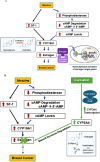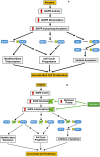Curcumin as an antidote to atrazine on estrogen homeostasis and beyond: mechanistic insights from a targeted literature review
- PMID: 40771272
- PMCID: PMC12325079
- DOI: 10.3389/fendo.2025.1553465
Curcumin as an antidote to atrazine on estrogen homeostasis and beyond: mechanistic insights from a targeted literature review
Abstract
As the most common cancer in women globally, breast cancer poses a significant public health concern. More concerning is its rising incidence rates in certain areas of the world, including Australia, New Zealand, Western Europe, and North America. Exposure to environmental endocrine-disrupting chemicals may play a role. One such chemical is atrazine (ATZ), a man-made herbicide highly prevalent in the environment and detectable in drinking water, with reported levels ranging from 0.026 to 1.29 micrograms per liter (µg/L) in surface waters in the United States. During the development of breast cancer, many factors are involved, in particular the female sex hormone estrogen. Estrogen signaling fuels the proliferation and migration of estrogen receptor (ER)-positive breast cancer. The current review presents multiple lines of qualitative evidence from in vitro, in vivo, and epidemiological studies connecting ATZ exposure to processes important for breast cancer development. Specifically, ATZ's stimulatory effect on breast cancer is mediated, at least partially, through enhanced CYP19A1 activity, the key enzyme converting testosterone to estradiol. ATZ stimulates CYP19A1 activity via parallel pathways, as evidenced by in vitro studies, potentially leading to elevated estradiol levels and estrogen signaling, which would then drive the development of ER-positive breast cancers. Beyond estrogen signaling, ATZ taps into the epidermal growth factor (EGF) signaling pathway to stimulate uncontrolled proliferation in human cell lines. We then show how curcumin, a phytochemical in turmeric, may counteract ATZ's effect on the aforementioned processes. Once curcumin passes through the ADME process and becomes available in the human body, curcumin may possess effects to counter ATZ's toxicity. Curcumin induces CYP3A4, as demonstrated by in vitro and in vivo studies, which catalyzes the degradation of steroid hormones, including estrogen. Curcumin downregulates the basal level of CYP19A1 in human cell lines via miRNA-125a and estrogen-related receptor alpha (ERRα), indicating an ability to dampen estrogen signaling. In addition, curcumin has been shown to inhibit the EGF receptor in human cell lines, thus blocking the EGF signaling cascade at the receptor level. Furthermore, curcumin may reduce ATZ's overall bioavailability. ATZ and its metabolites undergo glutathione (GSH) conjugation followed by renal excretion. Curcumin helps maintain the GSH pool and activates glutathione-S-transferase (GST) in rats, thereby potentially facilitating the detoxification and elimination of ATZ. In conclusion, we propose that curcumin's ability to induce CYP3A4, suppress CYP19A1, inhibit EGF signaling, and promote detoxification and elimination of ATZ makes curcumin a promising candidate for a mechanism-based antidote to ATZ toxicity.
Keywords: CYP19A1; CYP3A4; EGF signaling; atrazine; breast cancer; curcumin; estrogen homeostasis.
Copyright © 2025 Wright, Ilali and Bu.
Conflict of interest statement
The authors declare that the research was conducted in the absence of any commercial or financial relationships that could be construed as a potential conflict of interest.
Figures






Similar articles
-
PROteolysis TArgeting Chimera (PROTAC) Estrogen Receptor Degraders for Treatment of Estrogen Receptor-Positive Advanced Breast Cancer.Target Oncol. 2025 May;20(3):431-444. doi: 10.1007/s11523-025-01137-5. Epub 2025 May 6. Target Oncol. 2025. PMID: 40327300 Free PMC article. Review.
-
Targeting tumour re-wiring by triple blockade of mTORC1, epidermal growth factor, and oestrogen receptor signalling pathways in endocrine-resistant breast cancer.Breast Cancer Res. 2018 Jun 8;20(1):44. doi: 10.1186/s13058-018-0983-1. Breast Cancer Res. 2018. PMID: 29880014 Free PMC article.
-
The Black Book of Psychotropic Dosing and Monitoring.Psychopharmacol Bull. 2024 Jul 8;54(3):8-59. Psychopharmacol Bull. 2024. PMID: 38993656 Free PMC article. Review.
-
Potential risk of premature ovarian insufficiency from atrazine exposure: insights into molecular pathways and regulatory implications.Toxicol Mech Methods. 2025 Aug 19:1-31. doi: 10.1080/15376516.2025.2543343. Online ahead of print. Toxicol Mech Methods. 2025. PMID: 40760981 Review.
-
Management of urinary stones by experts in stone disease (ESD 2025).Arch Ital Urol Androl. 2025 Jun 30;97(2):14085. doi: 10.4081/aiua.2025.14085. Epub 2025 Jun 30. Arch Ital Urol Androl. 2025. PMID: 40583613 Review.
References
-
- World Cancer Research Fund. Breast cancer statistics. London: World Cancer Res. Fund; (2025). Available online at: https://www.wcrf.org/preventing-cancer/cancer-statistics/breast-cancer-s....
Publication types
MeSH terms
Substances
LinkOut - more resources
Full Text Sources
Medical
Research Materials

